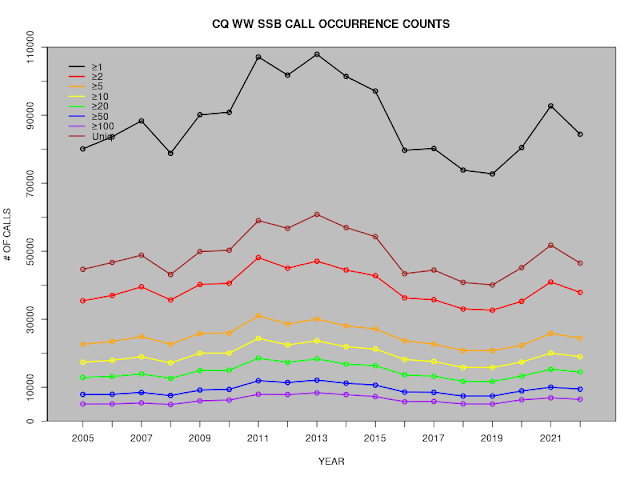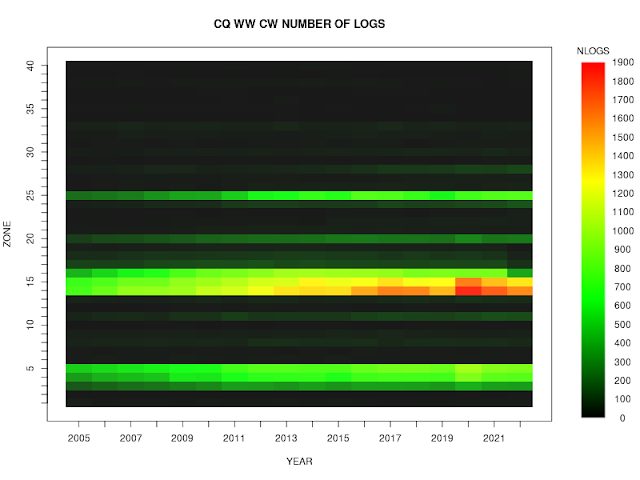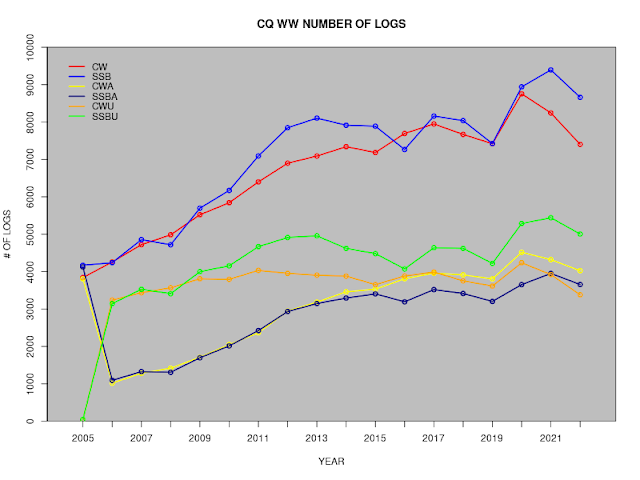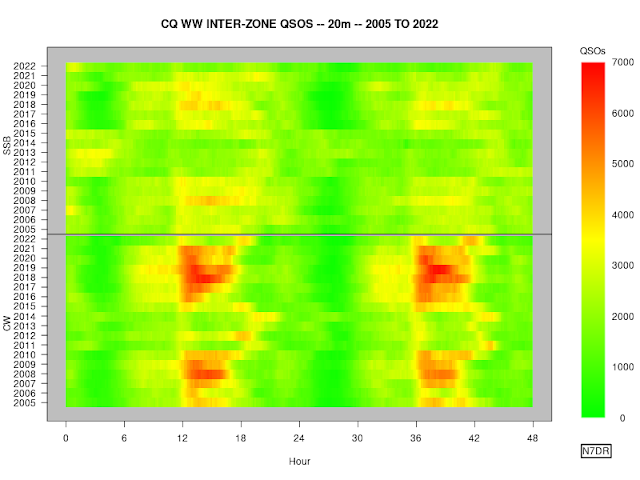A huge number of analyses can be performed with the various public CQ WW logs (cq-ww-2005--2022-augmented.xz; see here for details of the augmented format) for the period from 2005 to 2022.
As in prior years, there follow a few basic
analyses that interest me. There is, of course, plenty of scope to use
the log files for further analyses, some of which are suggested by the figures below.
Below are some simple analyses of
basic statistics from the logs. The 2022 versions of the contests were,
of course, run under unusual circumstances: much of the world was still in thrall to the COVID-19 pandemic circumstance; and then there was the unprecedented (at least in modern times) invasion of Ukraine. The CQ WW organisers vacillated on the latter topic. At the time of the contest, logs could be submitted by Russia and Belarus (hereinafter "UA" and "EW" respectively), and QSOs with stations in those countries counted for points. However, this change was announced rather late. And, of course, many people who were active in prior years protested this relaxation of the organiser's prior stance by refusing to take part in this year's contests (or, having taken part, declining to submit a log). So we can expect the data for 2022 to be unlike those for any other
year.
Number of Logs
Until 2020, the raw number of submitted logs for SSB had been relatively
flat for
several years; the logs submitted for CW showed a fairly
steady annual increase. In 2020, unsurprisingly, the number of logs in
both modes increased to new record, probably because of the pandemic; CQ WW SSB 2021 set another record;
on CW, the number of logs decreased slightly, but would still have been a
record were it not for 2020. 2022 was another year of unusual circumstances: not only was the pandemic still in evidence in much of the world, but the Russian invasion of Ukraine, along with the CQ WW committee's vacillation on how to proceed in light of that invasion -- and then the protest against the committee's position as of the contest dates -- was always going to lead to a reduction in the number of submitted logs.
One not infrequently reads statements to the effect that the popularity of contests such as CQ WW has long been increasing. This plot suggests that this claim had not been true for a number of years prior to 2020 (and even when it was true, there are alternative explanations for the year-on-year increase, such as increasing ease of electronic log submission). The circumstances for 2020, 2021 and 2022 have been so unusual that it would seem to be an error to try to predict what will happen in the next two or three years or to discern any reliable pattern based on log submissions from those three years.
Popularity
By definition, popularity requires some measure of people (or, in our case, the simple proxy of callsigns) -- there is no reason to believe, a priori,
that the number of received logs as shown above is related in any
particular way to the popularity of a contest, despite non-infrequent
conclusory statements to the contrary.
So we look at the number of calls in
the logs as a function of time, rather than positing any kind of
well-defined positively correlated relationship between log submission
and popularity (actually, the posts I have seen don't even bother to
posit such a relationship: they are silent on the matter, thereby simply
seeming to presume that the reader will assume one).
However, the situation isn't as
simple as it might be, because of the presence of busted calls in logs.
If a call appears in the logs just once (or some small number of times),
it is more likely to be a bust rather an actual participant. Where to
set a cut-off a priori in order to discriminate between busts and
actual calls is unclear; but we can plot the results of choosing
several such values.
First, for SSB:
Regardless
of how many logs a call
has to appear in before we regard it as a legitimate callsign, the
popularity of CQ WW SSB since the start of the pandemic has surely
increased from the doldrums of the prior few years. Whether this contest
is more
popular than it was at a similar point in the last solar cycle is
unclear, but it does seem to have held its own. Vitiating this effect in 2022 is, of course, the reduction in participation that is (presumably) due to the Russian invasion of Ukraine.
[I note that a reasonable argument
can be made that the number of uniques will be more or less proportional
to the number of QSOs made (I have not tested that hypothesis; I leave
it as an exercise for the interested reader to determine whether it is
true), but there is no obvious reason why the same would be true for,
for example, callsigns that appear in, say, ten or more logs. The interested reader might also consider basing a similar analysis on eXtended Super Check Partial files as created by the drscp program.]
Moving to CW:
On CW, we see that in 2022 the reduction due (presumably) to the Russian invasion of Ukraine has led to the number of active calls being the lowest of all the years for which data are available.
Geographical Participation
How has the geographical distribution of entries changed over time?
Again looking at SSB first:
The big news is the precipitous drop in entrants from zone 16, with smaller but still considerable drops from zone 15 and zone 14 -- none of which, of course, is surprising. Zone 28 continues to show an increase in the number of logs submitted, to the point where it is now not dissimilar to the number from zone 25. Still, the number of logs from zones outside EU or the US continues to be very small. This can be seen more clearly if we plot the percentage of logs received from each zone as a function of time:
In 2022, entrants from zone 16 dropped from the historical value of around 10% to close to zero. The slack was taken up principally by the US zones and zones 11 and 25.
On CW, most zones evidence a sustained long-term increase:
Again we see the expected drop in entries from zone 16, but other than that trends continue more or less as before, with the relative increase spread more or less evenly across all zones, with the percentages of logs from each zone barely changing except for the pandemic years:It is, I think, of some interest that the change in participation in zone 28 that is obvious on SSB is only gradually making itself felt on CW. Zone 24 is gradually becoming more common, although it is still far behind the powerhouse that is zone 25.
Activity
Total activity in a contest depends
both on the number of people who participate and on how many QSOs each
of those people makes. We can use the public logs to count the total
number of distinct QSOs in the logs (that is, each QSO is counted only once, even if both participants have submitted a log).
For SSB:
Ignoring the anomalous nature of 2022, the
total number of distinct QSOs is
essentially the same as at the same point in the last solar cycle.
And for CW:
As on SSB, it is probably best not to read much into the data point for 2022, as the circumstances were so different, particularly in Europe, which is the source of a large proportion of the QSOs in this contest (well, in almost every international contest, really).
To repeat what I said last year: on this mode there continues to be, it seems, a long-lived underlying upward trend (on which the effect of the solar cycle is superimposed), perhaps augmented somewhat by the pandemic in 2020 (but not in 2021 for some reason). Despite the claims I see that CW is an obsolete technology in serious decline, the actual evidence, at least from this, the largest contest of the year, continues to be quite the opposite. (This is a good reminder that when someone makes a claim whose truth is not self-evident, one should examine the underlying data for oneself. I have found that all too often it transpires that no defensible evidence has been put forward for the conclusion being drawn.) The evidence certainly seems to indicate that CW activity is healthy, at least insofar as CQ WW is concerned.
It is worth noting that, during the 2021 running of the SSB contest, it is quite clear that cycle 25 had an impact, whereas a month later on CW conditions had returned to the doldrums.
Running and Calling
On SSB, the ongoing gradual shift towards stations strongly favouring
either running or calling, rather than splitting their effort between
the two types of operation, finally appears to have reached some kind of
equilibrium. There was essentially no change between 2018 and 2019, and even a (very) slight reversal of the trend in 2020 and 2021. 2022, however, for the first time saw more than 30% of entrants making no run QSOs at all:
I have not investigated the cause of the decrease in the
percentage of stations strongly favouring running, although the public
logs could readily be used to distinguish possibilities that spring to
mind, such as more SO2R operation, more multi-operator stations, and/or a
reluctance of stations to forego the perceived advantages of spots from
cluster networks.
On CW, the split between callers and runners continues to be much less
bimodal than on SSB (as mentioned above, on SSB, fully 30% of entrants have no
run QSOs; on CW, the equivalent number is below 10%). Indeed, the
difference in call/run behaviour on the two modes (and the difference in
the way that the behaviour has changed over time) is profound, and
probably worthy of further investigation. CW continues to appear to exhibit
what would seem to be a much healthier split between the two operating
styles:
Assisted and Unassisted
We can see how the relative popularity of the assisted and unassisted categories has changed since they were introduced:
On CW, there continue to be more or less equal numbers of assisted and unassisted
logs, while on SSB the unassisted logs handily exceeds the number of
assisted logs. My guess, for what it's worth, is that CW assistance is
more widespread partly because it (partially) absolves stations from
actually being able to copy at high speed, and partly because the RBN is
so effective that essentially all CQing stations are spotted.
I find it particularly interesting that the number of CWU logs has
remained essentially unchanged ever since the unassisted category was
created.
Looking at the number of QSOs appearing in the unassisted and assisted logs:
(The lines are for the median number of logs; the vertical bars run from 10% to 90%, 20% to 80%, 30% to 70%, 40% to 60%, with opacity increasing in that order.)
A long-term downward trend in the numbers of QSOs in the assisted logs
ceased in 2016, and since then the median number of QSOs in the
assisted logs has remained essentially unchanged. A more or less
constant difference of roughly one hundred QSOs between
the median CW and SSB logs (in favour of CW) continues.
Inter-Zone QSOs
We can show the number of inter-zone
QSOs, both band-by-band and in total. In these plots, the number of QSOs
is accumulated every ten minutes, so there are six points per hour.
The new cycle is starting. Unfortunately, the CW event suffers by a month later in the year than the SSB event. [I do not understand why the CQ WW committee do not alternate the weekends of the SSB and CW modes; but then, I don't understand a lot of what they do or don't do.]
2022 saw fairly ordinary 15m participation on SSB, probably because of signs of activity on 10m. CW saw more activity, presumably because 10m did not cooperate to the same extent as it did on SSB.
Much less activity on 20m, in both modes. Partly because of better conditions on 10m and 15m, but also because of the decreased activity in generaly, probably caused by the Russian invasion of Ukraine.
As always, CW dominates on 40m; and, within that mode, intra-EU QSOs further dominate. The effect of the Russian invasion (presumably that is the cause of the decreased activity) made itself after the first few hours and persisted through the rest of the weekend.
80m is always dominated by CW; but this year saw what appears to be a record low level of activity, presumably because of the invasion.
160m paints a similar story to 80m, although the raw QSO counts are much lower, and appear to have sunk to a record low.
The overall picture shows the influence of the new solar cycle; but it is clear that the normal ramp-up has not appeared in this cycle, probably due to the invasion.























No comments:
Post a Comment
Note: Only a member of this blog may post a comment.